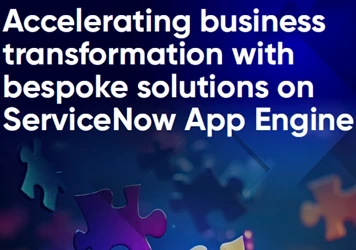Ultimate guide to transformational leadership
How the transformational leadership model can inspire unexpected and remarkable business results
Add bookmark
The transformational leadership model can inspire unexpected and remarkable business results – in this guide we explain how.
To overcome challenges related to market disruption, economic factors or stale organizational cultures, businesses can turn poor performance around by placing transformation at the heart of their strategy. Transformational leadership offers them an opportunity to maximize the potential of their employees by inspiring them to achieve outstanding results.
Read on to discover the business benefits of adopting a transformation leadership model and find out which traits make for true transformational leaders.
Join the PEX Network community

Don't miss any news, updates or insider tips from PEX Network by getting them delivered to your inbox. Sign up to our newsletter and join our community of experts.
Learn MoreContents
- What is transformational leadership?
- Why transformational leadership benefits businesses
- The four I's of transformational leadership
- Transformational vs transactional leadership
- Transformational leaders in action
- The tools you need for transformational leadership
- Know which leadership model to use
- Common pitfalls to avoid
What is transformational leadership?
The transformational leadership approach involves putting personal interest aside and focusing on the needs of others to create a culture in which the organization can flourish and succeed. Transformational leaders can identify where change is needed, create a vision for the future and guide an organization through the process of making it a reality.
The art of transformational leadership involves motivating employees with passion and drive. The leader becomes a role model, building loyalty and commitment by exhibiting integrity and responsibility. Autonomy is championed, with employees encouraged to take ownership of their work.
Inspired by the transformational leadership style, workers raise their performance to support and emulate the leader, looking beyond self-interest and working as part of a collective effort to innovate and improve.
Why transformational leadership benefits businesses
Transformational leadership can offer a viable alternative to the transactional leadership model (more on this later), and its onus on integrity and the greater good can provide a solid foundation for a healthy culture.
With employees empowered to step up and realize their potential, an agile and responsible workforce can be created, helping the organization achieve lasting success and resilience in the face of disruption.
The leadership style can also have a positive effect on the wellbeing of employees, with workers feeling valued, positive about their work and clear about their purpose within the organization.

The four I's of transformational leadership
Although you could argue that transformational leadership has been with us since time immemorial and some commentators cite historical exponents such as Gandhi and Martin Luther King, the term was first coined by sociologist James V. Downton in 1973. Leadership expert James MacGregor Burns expanded upon the concept in 1978 before researcher Bernard M. Bass picked up the baton and developed what is known as Bass’ Transformational Leadership Theory in 1985.
Looking at the characteristics, behaviors and psychological attributes of transformational leaders, Bass identified four distinct features, known as the four I’s. These are:
Idealized influence: Effective transformational leaders model the behaviors required from others and have the charisma to inspire employees to follow and emulate them.
Individual consideration: Transformational leaders show concern for others and attend to their personal needs. They exhibit genuine empathy and emotional intelligence.
Inspirational motivation: Transformational leaders can inspire employees and teams by clearly articulating a compelling vision, building a sense of purpose and drive. They use simple, positive language and set clear goals.
Intellectual stimulation: Transformational leaders recognize that employees need to be stimulated to realize their potential, so they create a culture that encourages the use of creativity and problem-solving skills. This helps to foster an environment that allows employees to become high performers.
Transformational vs transactional leadership
As mentioned earlier, transformational leadership is an effective alternative to transactional leadership.
Although motivation and goals are at the heart of both styles, as is the shared purpose of achieving positive results, there is a stark contrast between the methods of the transactional leader and those of their transformational counterpart.
Transactional leadership is a more directive style of management, with control as the foundation rather than role-modeling. Reward and punishment is used for motivation; for example, an employee will be rewarded for finishing a task on time but penalized for failure to do so. In this way, the model relies more on self-interest than the greater good, with the leader exerting power within the existing organizational culture.
For the transactional approach, there is much more onus on the short-term when it comes to strategy and goals, and objectives involve maintaining the status quo rather than change.
Overall, transactional leaders are responsive rather than proactive, and bureaucratic as opposed to charismatic. A transactional leader is more focused on planning and execution rather than inspiring others, with employees steered towards procedure and compliance rather than innovation and creativity.

Transformational leaders in action
There are many well-known leaders in the business world who have used the transformational approach with great success.
John D. Rockefeller is often cited as one of the earliest examples. Building the Standard Oil empire in the late 19th and early 20th century and becoming arguably the wealthiest person in modern history in the process, Rockefeller’s success is sometimes attributed to the way he was able to focus his company’s workforce around the vision he created. A transformational style is certainly suggested by one of his most famous quotes:
“Good leadership consists of showing average people how to do the work of superior people.”
However, there is no need to go too far back in history. Several well-known transformational leaders have played a major role in shaping the world we live in today.

Steve Jobs: A leadership model for the tech world
Take the late Steve Jobs, for example. The Apple co-founder, chairman and CEO was a prime example of a charismatic and authentic leader who created a vision, then inspired and motivated others to bring it to life. The culture of innovation at Apple has led to game-changing technologies and Jobs’ collaborative, inspirational style is encapsulated in quotes such as:
“Great things in business are never done by one person – they’re done by a team of people,” and, “everyone here has the sense that right now is one of those moments when we are influencing the future.”
It is often said that transformational leadership is especially suited to tech companies, and that is further borne out by the example of Microsoft CEO Satya Nadella.
When Nadella took the helm of the tech giant in 2014, he quickly identified areas for improvement and change, one of them being the company’s culture. He instilled a more collaborative approach, not just within the organization but externally too, releasing Microsoft’s Office suite for Apple’s iOS platform.
Moreover, Nadella articulated his vision to employees immediately, using inspirational language. In his first email as CEO, he told them:
“We need to believe in the impossible and remove the improbable [and] this starts with clarity of purpose and sense of mission that will lead us to imagine the impossible and deliver it.”
He also emphasized the shared purpose by saying that “every one of us needs to do our best work, lead and help drive cultural change”.

Dr Kiran Mazumdar-Shaw: Leading India’s largest biopharma company
Dr Kiran Mazumdar-Shaw’s career is a perfect example of how determination and resilience can create long-lasting change.
She initially intended to follow her father’s footsteps in the brewing industry and trained as a brewmaster, only to be told she would never be hired in her native India because “it's a man's work”. This spurred a change in direction and she put her knowledge of chemistry to use by establishing a biotechnology company in her garage.
Mazumdar-Shaw struggled to build a team at first; this was 1978 when having a woman as a boss was not commonplace. She eventually found people she could train who were willing to work for her, some of whom stayed at the company for decades.
“I would like to be remembered as someone who made a difference to global healthcare through affordable innovation.”
The company, named Biocon Biochemicals, grew from industrial enzyme production to developing therapies for cancer and diabetes. A key aim of Mazumdar-Shaw's was to provide affordable medicines, and to date Biocon has supplied more than two billion affordable doses of insulin to patients around the world. Her compassionate approach has led the company to great success, becoming the largest producer of insulin in Asia.
Mazumdar-Shaw’s commitment to putting patients before profit extends to her personal fortune, as in 2016 she pledged to give away 75 percent of her wealth to philanthropic causes.
Today Mazumdar-Shaw is ranked among Forbes magazine’s “World’s 100 Most Powerful Women” and Fortune’s “Top 25 Most Powerful Women in Asia-Pacific.”

Rich Teerlink: How one leader transformed Harley-Davidson’s model
Away from the world of tech, a prime example of transformational leadership comes from motorcycle manufacturer Harley-Davidson. In the book More Than a Motorcycle: The Leadership Journey at Harley-Davidson, Rich Teerlink recalled his thoughts upon becoming president and COO of the company in 1987 after it had successfully fought for survival through seven years of crisis.
Teerlink realized that the challenge for the company was to sustain its progress and he formed a vision of how that could be achieved. “We needed to create an environment at Harley where everyone took responsibility for the company’s present and its future,” he said.
“People are an organization’s only sustainable competitive advantage.”
Teerlink, who became CEO of the company in 1989, believed that a leader should “be an outspoken advocate for employees, making sure they are front and center in an organization”. He collaborated with teams to formulate a plan for the future, which was then communicated to the wider company.
Having transformed the organization from a traditional top-down hierarchy to a more inclusive model, Teerlink retired as CEO in 1999 but acknowledged that “the work is not done” and that transformation is a continuous process.
Photo credit: Government House
Jacinda Ardern: Leading with empathy
Numerous academics have written about the empathic, compassionate leadership style of New Zealand’s Prime Minister Jacinda Ardern, highlighting the differences in her approach compared to other world leaders.
Ardern has faced two major crises that have demonstrated her radically different approach to leading. The first was the terrorist shooting in the Christchurch mosque that killed 51 people. Ardern swiftly moved to ban assault weapons and ensure funeral costs for all the victims were covered, regardless of their immigration status.
“One of the criticisms I’ve faced over the years is that I’m not aggressive enough or assertive enough, or maybe somehow, because I’m empathetic, it means I’m weak. I totally rebel against that. I refuse to believe that you cannot be both compassionate and strong.”
When the Covid-19 pandemic emerged she sought to protect the health of citizens with a zero Covid policy that closed the country’s borders and shut down the country for 11 weeks, during which time she hosted regular Facebook Live streams to answer questions from the public.
The strict response was considered one of the most successful in the world, yet Ardern has since announced that the government is launching an official inquiry for future administrations to be better prepared should there be another health emergency, stating that “it’s critical we compile what worked and what we can learn from it should it ever happen again.”
The tools you need for transformational leadership
A helpful approach for potential transformational leaders looking to formulate the purpose and direction of an organization is a technique developed by leadership author Simon Sinek in his book Start with Why: How Great Leaders Inspire Everyone to Take Action.
This method is based on a ‘golden circle’ of concentric rings, with ‘why’ in the center, followed by ‘how’ and ‘what’ moving outwards. By using these questions in order and in context of the organization, leaders can develop and explore their vision and how to turn it into reality.
Aspiring transformational leaders should also look to develop their communication skills. Storytelling can be an effective way of articulating a vision and inspiring others.
Relevant areas for coaching also include change management, emotional intelligence and business strategy.

Know which leadership model to use
Despite the reported positive effects of transformational leadership and the high-profile examples of success, it is neither an easy method to follow nor a surefire route to positive change.
Firstly, the environment must be suitable. One of the major pitfalls is employing the transformational model where a transactional style would be more appropriate.
Transactional leadership can be more effective in a settled environment that benefits from routine, structure and efficiency. Similarly, high-risk environments might favor transactional leadership over the transformation model where failure or errors can be tolerated on the path to progress.
Finally, avoid these common pitfalls
Also, as discussed earlier, transformational leadership requires specific traits. If a leader is lacking in the necessary charisma, authenticity or communication skills and they fail to create a compelling case for their vision, they will lack credibility and the necessary buy-in with the workforce.
Another often-cited pitfall is potential burnout among employees. The commitment and responsibility required of the workforce can lead to long hours and going ‘above and beyond’, which can counterbalance or negate the positive effects of transformational leadership.
There is also the risk of the leader lacking the necessary patience to make the transformation model work. As Harley-Davidson’s Rich Teerlink observed, “Transforming a culture takes time.”
To avoid these pitfalls, it is important that leaders take time to properly assess the needs of the organization, as well as any areas of their own personal development that need to be addressed to help them succeed. They should also ensure that the principle of putting others first extends to monitoring how the transformational methods are affecting employees, putting early warnings in place for signs of burnout or growing cynicism.
The added effort could pay dividends when it comes to helping people achieve extraordinary results.
Accelerating business transformation with bespoke solutions on ServiceNow App Engine

Today, off-the-shelf software solutions offer diverse features that enable vast opportunities to implement and maintain business transformation. However, in some circumstances, capabilities lack the flexibility and specificity required to address the unique challenges and workflows of individual organizations. As a result, there is a growing shift toward bespoke application development – custom-built solutions that align precisely with strategic goals and operational demands.
Download this report to explore how enterprises can harness the power of custom applications to drive meaningful transformation. With the growing adoption of low-code platforms like ServiceNow App Engine, organizations are building custom applications faster and with greater control. By empowering both IT professionals and citizen developers to build tailored solutions, organizations can significantly reduce time to value while maintaining control over quality and compliance.
Download Now

























